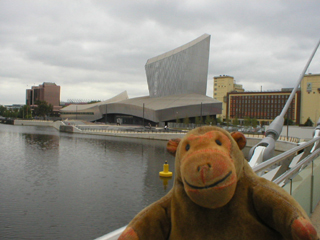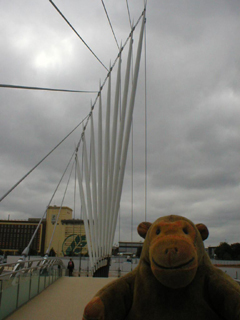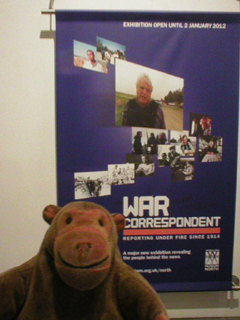Mr Monkey knew that a new exhibition called
War Correspondent : reporting under fire since 1914 had opened at Imperial Museum North, so he took a train and a tram to Salford Quays.

After he'd got off the tram at Harbour City, Mr Monkey peered into the distance and wondered if the new footbridge he'd seen standing on the bank next to the IWM when he went on a
Mancunian Canal Cruise in October had actually been installed. So he led his humans through the not-quite finished MediaCityUK complex and found that the bridge was in place, and, indeed had been officially opened by the Archbishops of York and Canterbury in March. Mr Monkey wasn't allowed to try the controls and see if the bridge could swing properly, so he had to assume it would. He did get a new view of the IWM North, and the new bridge is an excellent way of crossing the water without getting wet.
Mr Monkey scurried into the museum, and went upstairs to the temporary exhibition area. Photography isn't allowed inside temporary exhibitions for copyright reasons, so he made Mr Rik put the camera away after he'd posed with the poster beside the doorway.
As Mr Monkey guessed from its name, the exhibition is about war reporting from 1914 to the present day. After briefly mentioning the Crimea (which is before 1914 and technically is outside the remit of the IWM), the exhibition details the reporting of the Great War, the Spanish Civil War, World War Two, Vietnam, the Falklands, Bosnia, the Gulf Wars and Afghanistan.
As well as talking in general terms about the reporting of each conflict, the exhibition focuses on individual reporters, such as Philip Gibbs, Martha Gellhorn, Clare Hollingworth, Alan Moorehead, Richard Dimbleby, Kate Adie, Martin Bell and John Simpson.
For each section there are recordings or filmed interviews of the reporters (or readings from their work), artefacts ranging from letters and diaries, paraphernalia such as insignia, typewriters, helmets and other tools of the trade. Additionally, the modern section includes Martin Bell's white suit, the mobile phone that stopped a bullet for cameraman Vaughan Smith, and the burqa that John Simpson wore to evade the Taliban in Afghanistan.
The exhibition ends with a discussion of future of war reporting in a world in which anyone with a blog can report on their own war zone and in which belligerents see reporters as legitimate (and easy) targets. Kate Adie points out, worryingly, that most reporters
"are killed by their own government or army".
Mr Monkey found
War Correspondents more interesting than he'd expected, though he prefered the earlier sections which were about people he hadn't seen on the TV news (the section on Philip Gibbs sent him scurrying off to
manybooks.net to see if any of his books were there); this is probably because he found familiar faces talking about what they'd done less appealing than finding out about reporters he hadn't heard of. Mr Money's favourite bit of the exhibition was the 1943 film about wartime cameramen.
Mr Monkey thinks that parents should be aware that this exhibition doesn't seem to have quite the same appeal to young children that earlier exhibitions at IWM North have had - there are no chances to dress up, no touch screen activities - and some of the footage is potentially disturbing.
War Correspondent : reporting under fire since 1914 runs until 2 January 2012.




 After he'd got off the tram at Harbour City, Mr Monkey peered into the distance and wondered if the new footbridge he'd seen standing on the bank next to the IWM when he went on a Mancunian Canal Cruise in October had actually been installed. So he led his humans through the not-quite finished MediaCityUK complex and found that the bridge was in place, and, indeed had been officially opened by the Archbishops of York and Canterbury in March. Mr Monkey wasn't allowed to try the controls and see if the bridge could swing properly, so he had to assume it would. He did get a new view of the IWM North, and the new bridge is an excellent way of crossing the water without getting wet.
After he'd got off the tram at Harbour City, Mr Monkey peered into the distance and wondered if the new footbridge he'd seen standing on the bank next to the IWM when he went on a Mancunian Canal Cruise in October had actually been installed. So he led his humans through the not-quite finished MediaCityUK complex and found that the bridge was in place, and, indeed had been officially opened by the Archbishops of York and Canterbury in March. Mr Monkey wasn't allowed to try the controls and see if the bridge could swing properly, so he had to assume it would. He did get a new view of the IWM North, and the new bridge is an excellent way of crossing the water without getting wet.